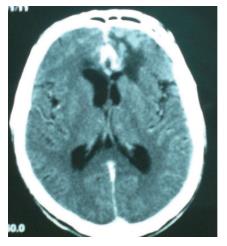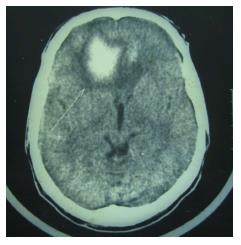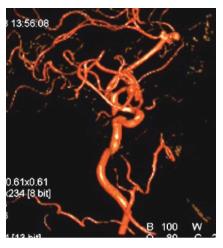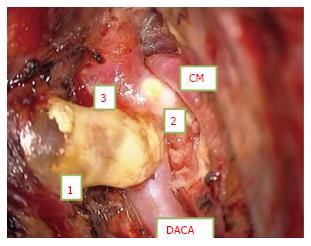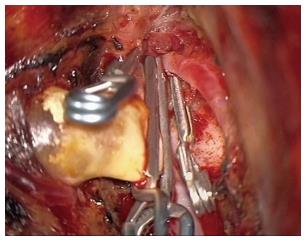Published online Apr 16, 2015. doi: 10.12998/wjcc.v3.i4.377
Peer-review started: September 22, 2014
First decision: December 17, 2014
Revised: January 16, 2015
Accepted: February 4, 2015
Article in press: February 9, 2015
Published online: April 16, 2015
Processing time: 203 Days and 11.9 Hours
Multiple saccular or giant aneurysms of azygos anterior cerebral artery (AACA) at the distal segments A2-A5 are very rarely reported. Distal anterior cerebral artery (DACA) aneurysms represent approximately 2%-7% of all cerebral aneurysms. We present the case of an Albanian 62-year-old male, admitted at our service after sudden onset of severe headache and vomiting. Computerized tomography (CT) of the head showed hemorrhage in the front of corpus callosum. CT angiography followed by digitally subtracted angiography (DSA) documented a large necked aneurysm with three lobes at the origin of calloso-marginal artery and a single DACA, also known as AACA. A frontal parasagittal craniotomy was performed. Obliteration of the aneurysm was done only by separate clipping of each three lobes at the respective neck. Postoperative DSA demonstrated complete exclusion of the aneurysm and a regular flow of AACA. The patient recovered uneventfully. Despite it is a rare occurrence, an aneurysm of distal segments of anterior cerebral artery A2-A5, concomitant to AACA should be studied with DSA. In the era of embolization, conserving good microsurgical skills is fundamental for dealing with multilobar cerebral aneurysms, associated with rare anatomical variations.
Core tip: This is a detailed description of radiological and surgical findings in a very rare case of trilobed aneurysm of distal anterior cerebral artery. The characteristics of this aneurysm are exposed and its difficult exclusion by separate three clips is argued with a thorough discussion of the literature.
- Citation: Seferi A, Alimehmeti R, Rroji A, Petrela M. Saccular trilobed aneurysm of azygos anterior cerebral artery. World J Clin Cases 2015; 3(4): 377-380
- URL: https://www.wjgnet.com/2307-8960/full/v3/i4/377.htm
- DOI: https://dx.doi.org/10.12998/wjcc.v3.i4.377
The incidence of true azygos distal anterior cerebral artery (DACA) ranges from 0% to 5%[1,2]. The rarest is the form of unpaired DACA. An azygos artery is better studied through carotid angiography with contralateral compression. In the presented case, there was a trilobed aneurysm of A3 segment in a single or azygos variant of DACA.
A 62-year-old man showed up at a local hospital complaining of severe headache with sudden onset. Neurological examination revealed nuchal rigidity but no neurological deficits. Unenhanced computed tomography (CT) of the head revealed a hyperdense lesion in front of the knee of corpus callosum interpreted as hemorrhage with edema of the left frontal lobe (Figure 1).
With the event taking place in 2008, a thorough history was requested. Back to 1990 the patient had been admitted at the same rural hospital after an episode of acute headache and loss of consciousness. A CT of the head at that time had shown same hemorrhage as in recent episode, but the patient had been discharged without any in-depth examinations or treatments (Figure 2).
At present episode the patient was promptly transferred at our neurosurgical facility. The CT angiography revealed A3 aneurysm of DACA. Digitally subtracted angiography (DSA) confirmed a trilobed and a complex broad-necked A3 aneurysm at the origin of the calloso-marginal (CM) artery (Figure 3), in presence of azygos anterior cerebral artery (AACA).
Cerebral DSA with contra-lateral carotid artery compression confirmed the presence of AACA. Endovascular option of treatment was not considered and microsurgical clipping of the aneurysm with or without a bypass was planned.
Left frontal parasagittal craniotomy anterior to coronal suture was done in order to control at first the distal tract of CMA. Once identified, the CMA led us to the pericallosal artery proximal to the aneurysm. Then the aneurysm with its three lobes was dissected exposing at first the proximal segment of pericallosal artery, although the interhemispheric approach offers small space. After clearing the adhesions, the broad aneurysm neck and its three lobes were exposed, each of which extended in a different direction (Figure 4).
The neck wall of the aneurysm was sclerotic. Single clip closure of the neck was initially tried, but its hard wall shifted the clip away towards the single pericallosal artery reducing its lumen. Therefore separate clipping was deemed the only possible way to exclude the aneurysm (Figure 5). Uneventful postoperative course followed. Carotid angiography documented preserved flow in the parent artery and complete exclusion of the aneurysm (Figure 6).
In 1963 Baptista[2] presented a scale of three groups for the anatomical variations DACA. Years before Wilders coined the term azygos pericallosal artery for the fusion of two A2 arteries. During angiographic and autopsy studies the incidence of this variation is reported from 0.3% to 2%[2-4]. The aneurysms of DACA are seen in 2%-6.7% of the intracranial aneurysms and they are usually saccular, small and single-lobed[2,5-7]. Giant aneurysms of azygos pericallosal artery and those multi-lobular are extremely rare, and usually situated at the calloso-marginal bifurcation[1,8-12]. Auguste et al[13] reported a series of 876 aneurysms surgically treated, with five ACA aneurysms in the presence of an azygos pericallosal artery that represent 0.5% and 1.7% of ACA and ACoA aneurysms of his series. It seems needless to stress the importance of angiography in such cases, not only for a preoperative evidence of the morphology of the aneurysm, but also for the documentation of any variation of AACA, which will influence the surgical technique.
In our reported case preoperative DSA showed a trilobed aneurysm originating from a single neck with different spatial orientation. Single clip closure of the neck was initially tried, but its hard wall shifted the clip away towards the single pericallosal artery reducing its lumen. Therefore we opted for a separate clipping.
The hypothesis of creation of three lobes stands on the blood flow dynamics of the parent artery. The more curved the parent artery, more blood enters the aneurysm.
In case of AACA the blood flow is increased compared with the blood flow of any of the ACAs in a normal anatomical setting. The angled direction of entry and increase of blood flow in the aneurysm space influence the stress over the aneurysm wall. Perioperative morphological study of the single pericallosal artery evidenced the location of the aneurysm at the knee of corpus callosum. At this point the pericallosal artery bends posteriorly. It creates the prerequisite of the scenario mentioned above, that favors aneurysm formation.
In order to explain the origin of such a rare morphology aneurysm, several experimental paradigms are suggested[14]. A larger neck width increases the blood flow rate within the aneurysm. Draining vessels from the aneurysm contribute in the increase of blood flow inside the aneurysm. Both factors increase the pressure on the aneurysm wall and influence multiple lobe formation[14-16].
We suppose that the three lobes in our case were influenced by a change of aneurysm neck and dome, perhaps due to the rupture eighteen years before. We also believe there might be a relationship between the previous supposed rupture of the aneurysm and its rare morphology.
The aneurysm conformation with three lobes, in the background of a very rare anatomical variation of ACA tract, makes our case a clinical rarity. The three lobes of the aneurysm we dealt with are the result of blood flow impact and parent vessel modification after the first hemorrhage, as documented with the CT performed more than a decade prior to the second episode, requiring neurosurgical intervention. We think that vascular neurosurgeons should be prepared to handle such complicated cases.
Three lobed azygos anterior cerebral artery (AACA) is an exception. Digitally subtracted angiography (DSA) is the gold standard method of study.
Repeated episode of subarachnoid hemorrhage was observed in this case.
The differential diagnosis with other type of acute onset of headache was done by computerized tomography scanner.
DSA showed AACA aneurysm unsuitable for embolization.
Surgical clipping was challenged by three lobed shape of the aneurysm, which was excluded only through separate clipping.
Excellent surgical skills are necessary for dealing with such rare difficult case.
Interesting case report.
P- Reviewer: Kawabori M, Said SAM, Schoenhagen P S- Editor: Ji FF L- Editor: A E- Editor: Lu YJ
| 1. | Jagetia A, Kumar PN, Sinha S, Sharma A. Saccular bilobed aneurysm of an azygos anterior cerebral artery. J Clin Neurosci. 2007;14:777-779. [RCA] [PubMed] [DOI] [Full Text] [Cited by in Crossref: 8] [Cited by in RCA: 11] [Article Influence: 0.6] [Reference Citation Analysis (0)] |
| 2. | Baptista AG. Studies on the arteries of the brain. ii. the anterior cerebral artery: some anatomic features and their clinical implications. Neurology. 1963;13:825-835. [RCA] [PubMed] [DOI] [Full Text] [Cited by in Crossref: 165] [Cited by in RCA: 140] [Article Influence: 4.7] [Reference Citation Analysis (0)] |
| 3. | Kayembe KN, Sasahara M, Hazama F. Cerebral aneurysms and variations in the circle of Willis. Stroke. 1984;15:846-850. [RCA] [PubMed] [DOI] [Full Text] [Cited by in Crossref: 174] [Cited by in RCA: 172] [Article Influence: 4.1] [Reference Citation Analysis (0)] |
| 4. | Lightfoote JB, Grusd RS, Nalls GA. Azygos anterior cerebral artery mimicking an anterior communicating artery aneurysm. AJNR Am J Neuroradiol. 1989;10:S74. [PubMed] |
| 5. | Inci S, Erbengi A, Ozgen T. Aneurysms of the distal anterior cerebral artery: report of 14 cases and a review of the literature. Surg Neurol. 1998;50:130-139; discussion 139-140. [RCA] [PubMed] [DOI] [Full Text] [Cited by in Crossref: 60] [Cited by in RCA: 48] [Article Influence: 1.7] [Reference Citation Analysis (0)] |
| 6. | Ng PY, Reilly PL, Brophy BP, Halcrow S. Distal anterior cerebral artery aneurysms: a clinical series. Br J Neurosurg. 1998;12:209-212. [RCA] [PubMed] [DOI] [Full Text] [Cited by in Crossref: 20] [Cited by in RCA: 20] [Article Influence: 0.7] [Reference Citation Analysis (0)] |
| 7. | Ohno K, Monma S, Suzuki R, Masaoka H, Matsushima Y, Hirakawa K. Saccular aneurysms of the distal anterior cerebral artery. Neurosurgery. 1990;27:907-912; discussion 912-913. [RCA] [PubMed] [DOI] [Full Text] [Cited by in Crossref: 64] [Cited by in RCA: 62] [Article Influence: 1.8] [Reference Citation Analysis (0)] |
| 8. | Topsakal C, Ozveren MF, Erol FS, Cihangiroglu M, Cetin H. Giant aneurysm of the azygos pericallosal artery: case report and review of the literature. Surg Neurol. 2003;60:524-533; discussion 533. [RCA] [PubMed] [DOI] [Full Text] [Cited by in Crossref: 20] [Cited by in RCA: 24] [Article Influence: 1.1] [Reference Citation Analysis (0)] |
| 9. | Hashizume K, Nukui H, Horikoshi T, Kaneko M, Fukamachi A. Giant aneurysm of the azygos anterior cerebral artery associated with acute subdural hematoma--case report. Neurol Med Chir (Tokyo). 1992;32:693-697. [RCA] [PubMed] [DOI] [Full Text] [Cited by in Crossref: 27] [Cited by in RCA: 27] [Article Influence: 0.8] [Reference Citation Analysis (0)] |
| 10. | Hayashi M, Kobayashi H, Kawano H, Handa Y, Kabuto M. Giant aneurysm of an azygos anterior cerebral artery: report of two cases and review of the literature. Neurosurgery. 1985;17:341-344. [RCA] [PubMed] [DOI] [Full Text] [Cited by in Crossref: 25] [Cited by in RCA: 27] [Article Influence: 0.7] [Reference Citation Analysis (0)] |
| 11. | Shiokawa K, Tanikawa T, Satoh K, Kawamata T, Kubo O, Kagawa M, Takakura K, Sentoh S. [Two cases of giant aneurysms arising from the distal segment of the anterior cerebral circulation]. No Shinkei Geka. 1993;21:467-472. [PubMed] |
| 12. | Yamagami T, Handa H, Hashimoto N, Nagata H, Watanabe H. Giant aneurysm of the azygos anterior cerebral artery. Nihon Geka Hokan. 1986;55:777-782. [PubMed] |
| 13. | Auguste KI, Ware ML, Lawton MT. Nonsaccular aneurysms of the azygos anterior cerebral artery. Neurosurg Focus. 2004;17:E12. [PubMed] |
| 14. | Hassan T, Timofeev EV, Saito T, Shimizu H, Ezura M, Matsumoto Y, Takayama K, Tominaga T, Takahashi A. A proposed parent vessel geometry-based categorization of saccular intracranial aneurysms: computational flow dynamics analysis of the risk factors for lesion rupture. J Neurosurg. 2005;103:662-680. [RCA] [PubMed] [DOI] [Full Text] [Cited by in Crossref: 139] [Cited by in RCA: 141] [Article Influence: 6.7] [Reference Citation Analysis (0)] |
| 15. | Schick RM, Rumbaugh CL. Saccular aneurysm of the azygos anterior cerebral artery. AJNR Am J Neuroradiol. 1989;10:S73. [PubMed] |
| 16. | Yasargil MG. Microneurosurgery, Volume I & II. Stuttgart: G. Thieme Verlag 1984; . |













